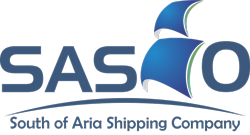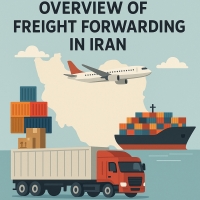Understanding the Role of Freight Forwarders in Iran
Freight forwarders in Iran are vital partners for international traders, streamlining logistics within the Iran supply chain. Positioned on the International North-South Transport Corridor (INSTC), Iran connects Asia, Europe, and the Middle East, making forwarders essential for cross-border commerce. They coordinate multimodal transport—sea, rail, and road—through hubs like Bandar Abbas, which handles 70% of Iran’s containerized cargo.
For merchants from CIS countries, Africa, India, and China, Iranian forwarders manage critical tasks: negotiating Incoterms (EXW, CIF, FOB), securing container bookings, and handling customs clearance under Iran’s regulations and TIR Carnet protocols. They mitigate challenges like sanctions and currency fluctuations, ensuring cost-effective freight rates and compliance with FIATA standards. Services include cargo consolidation, breakbulk handling, and real-time tracking via ERP systems, offering transparency for global clients.
Forwarders leverage Iran’s strategic location to facilitate trade with neighboring countries and beyond, such as expedited transit to Russia or cost-competitive routes to India. In 2024, Iran’s logistics sector managed 150 million tons of cargo, underscoring forwarders’ role in sustaining trade flows. Their expertise in navigating regulatory complexities makes them indispensable for seamless, reliable logistics.
Structure and Dynamics of Iran’s Freight Forwarding Market
The Iran freight market is a vibrant sector shaped by a diverse mix of large and small operators. Freight forwarding in Iran serves as a critical link for trade, supported by a robust network of ports, railways, and highways. Large, often state-affiliated firms handle bulk contracts, while smaller forwarders provide agile Iran logistics services, offering cost-effective, tailored solutions for traders from Afghanistan, CIS, Africa, India, and China. These nimble firms excel in flexibility, making them ideal for merchants seeking personalized logistics.
The competitive landscape of freight forwarding in Iran is driven by economic and technological shifts. Infrastructure upgrades, like railway expansions targeting 2500 km by 2028, enhance connectivity. However, sanctions and currency instability impact freight pricing. Digital tools, such as ERP and blockchain for documentation, are defining transport and shipment to/from Iran in 2025, improving efficiency. Smaller forwarders, with their adaptability and client-focused approach, are increasingly vital for international traders navigating this evolving market.
Key Services Offered by Freight Forwarding in Iran
Freight forwarding in Iran provides essential logistics services for global traders, ensuring efficient movement of goods. Below are the core services shaping the Iran transportation industry.
Multimodal Transportation
Iranian forwarders excel in multimodal transport services in Iran, combining sea, rail, road, and air to optimize routes. Leveraging Iran’s strategic ports and rail networks, they ensure cost-effective delivery to destinations like Russia or India, adapting to diverse cargo needs.
Customs Clearance
The customs clearance process in Iran is streamlined by forwarders who manage documentation, tariffs, and compliance with local regulations, including TIR Carnet protocols. Their expertise minimizes delays, ensuring smooth trade for international clients.Some companies, like SASCO, also provide both cargo transportation and customs clearance Iran services, offering integrated solutions.
Container Booking and Cargo Handling
Forwarders secure container space and provide professional cargo handling, including packaging and labeling to meet global standards. These services ensure safe transit, critical for traders in the Iran transportation industry.
Value-Added Services
Smaller forwarders offer Iran logistics services like cargo insurance, warehousing, and real-time tracking via ERP systems. These enhance transparency and reliability, appealing to merchants seeking customized solutions in freight forwarding in Iran.
Barriers and Advantages of Working with Iranian Freight Forwarders
Freight forwarding in Iran is a pivotal service for international traders from CIS, Africa, Afghanistan, and China, offering access to a strategic trade hub through Iran logistics services. While collaboration presents challenges, the advantages make Iran an attractive logistics partner.
Key Challenges
The challenges of freight forwarding in Iran are multifaceted. Trade sanctions, imposed by various global entities, restrict banking transactions, as many international banks avoid Iran due to compliance risks, complicating payment processes. The customs clearance Iran process, governed by complex regulations, often involves bureaucratic delays, requiring extensive documentation like bills of lading and certificates of origin. Currency fluctuations, driven by Iran’s economic volatility, create uncertainty in freight rates, impacting budgeting for traders. Additionally, geopolitical tensions can disrupt trade routes, necessitating agile contingency planning to maintain supply chain continuity.
Strategic Advantages
The advantages of using Iranian freight forwarders are compelling. Iran’s geographic position as a bridge between Asia, Europe, and the Middle East enables cost-efficient trade routes, with transiting through Iran being significantly cheaper than bypassing it via neighboring countries like Turkey or the UAE.
Decades of navigating sanctions have equipped forwarders with unparalleled expertise in devising innovative, agile solutions, such as alternative payment channels and optimized routing, ensuring seamless trade flows.
In the Iran transportation industry, forwarders leverage modern tools like ERP systems for real-time cargo visibility, enhancing reliability. As a regional powerhouse, Iran facilitates faster, safer, and more secure connections with neighbors, including Iraq, Turkmenistan, and Afghanistan, simplifying trade logistics.
Competitive pricing, driven by Iran’s $400 billion economy, further attracts traders seeking value.
Building Effective Partnerships
Maximizing success in freight forwarding in Iran requires strategic collaboration. Forwarders’ deep knowledge of local regulations and market dynamics mitigates bureaucratic hurdles, ensuring compliance and efficiency. Building trust through clear communication and cultural sensitivity is essential, particularly for navigating Iran’s relationship-driven business environment. By aligning expectations and leveraging forwarders’ expertise, traders can unlock Iran’s full potential as a logistics hub, strengthening cross-border commerce.
Regulatory Framework Governing Freight Forwarding in Iran
Freight forwarding in Iran operates under a robust regulatory framework, shaping Iran logistics services for traders from CIS, Africa, India, and China. Understanding these regulations is key to navigating the Iran transportation industry.
Customs and Trade Regulations
The Iran Customs Service (IRICA) overseas freight forwarding in Iran, mandating documents like commercial invoices, packing lists, and certificates of origin. Tariffs, based on the Harmonized System (HS), range from 5% to 150%, with exemptions for capital goods to support industrial growth. The customs clearance Iran process adheres to international protocols like TIR Carnet, facilitating efficient cross-border trade. However, bureaucratic requirements can delay clearances, necessitating expert navigation.
Sanctions and Financial Compliance
The sanctions impact on freight forwarding in Iran is significant, with U.S. OFAC restrictions limiting banking transactions, particularly for petroleum-related trade. Forwarders mitigate these through barter trade, local currency payments, or third-country intermediaries, ensuring compliance with global trade regulations. Currency volatility adds complexity, requiring adaptive financial strategies to stabilize freight costs.
Transportation and Safety Standards
The Ministry of Roads and Urban Development regulates the Iran transportation industry, enforcing standards for multimodal transport across sea, rail, and road. Ports comply with International Maritime Organization (IMO) safety protocols, while air freight adheres to Iran Civil Aviation Organization rules for high-risk cargo. Environmental regulations promote route optimization and low-emission vehicles, aligning with global sustainability goals.
Licensing and Professional Standards
Freight forwarders must obtain licenses from the Ministry of Industry, Mine, and Trade. Compliance with Iran freight market regulations, including FIATA standards and local association guidelines, ensures professionalism. Despite bureaucratic hurdles, forwarders’ expertise in navigating complex regulations strengthens their role in global trade networks.
Forecasting the Future: Freight Market Trends in Late 2025 and Beyond
The Iran freight market is poised for strong growth in late 2025 and beyond, fueled by technological advancements, infrastructure upgrades, and evolving global trade dynamics. Freight forwarding in Iran serves as a vital pillar of the supply chain, with key trends shaping the transportation industry and logistics services.
Digital Innovation in Freight Forwarding
By late 2025, blockchain will streamline customs clearance in Iran, cutting delays and ensuring compliance with freight forwarder regulations. AI-driven tools will enhance multimodal transport, enabling shipping companies to offer competitive rates for international freight despite economic fluctuations. IoT-powered tracking boosts transparency, positioning freight forwarders in the global supply chain as a preferred choice for traders from CIS, Africa, and Asia. This aligns with the role of freight forwarders in logistics, driving efficiency and trust.
Infrastructure and Connectivity
The structure of the logistics market is bolstered by railway expansions (targeting 2500 km by 2028) and upgrades to ports like Chabahar and Bandar Abbas. Chabahar is emerging as a hub for freight forwarding market analysis, facilitating trade with India and Africa. The International North-South Transport Corridor (INSTC) accelerates multimodal transport to Russia and Europe, underscoring the importance of freight forwarding in trade.
Sustainable Logistics
The transportation industry is embracing green practices. Freight forwarder responsibilities include optimizing routes to reduce emissions and adopting energy-efficient vehicles. Government initiatives, such as rail electrification, align with global standards, attracting eco-conscious traders and enhancing logistics services.
Navigating Challenges
Despite sanctions, how freight forwarders operate demonstrates resilience. Alternative payment systems, like barter trade, mitigate banking constraints, while expertise in freight forwarder regulations ensures seamless international freight. Smaller firms among the key players in the freight forwarding industry provide agile solutions for markets like Afghanistan.
Trade Partnerships
Strengthened ties with China, India, and Russia through the Belt and Road Initiative boost cargo volumes. Enhanced agreements with Iraq and Turkey streamline the supply chain, lowering costs for shipping companies.
Outlook
With cargo volumes expected to surpass 160 million tons in late 2025, the freight market thrives on innovation and strategic positioning. Partnering with forwarders unlocks cost-competitive access to global markets, reinforcing the importance of freight forwarding in trade.
SASCO: Your Partner in Seamless Trade
SASCO streamlines freight forwarding in Iran, delivering efficient Iran logistics services through ports like Chabahar. With expertise in navigating the Iran freight market, SASCO ensures cost-effective, transparent solutions for global traders. Optimize your supply chain with SASCO’s reliable logistics. Contact us at http://www.sascompany.ir/en/ today!







